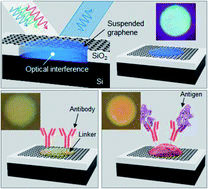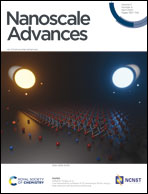A suspended graphene-based optical interferometric surface stress sensor for selective biomolecular detection†
Abstract
Graphene-based sensors are of great interest in research due to their high specific surface area and high electron mobility that make them suitable for numerous advanced applications. In this paper, selective molecular detection using an antigen–antibody reaction on suspended graphene with a cavity-sealing structure was demonstrated. The suspended graphene sealed nanocavities in a pre-patterned Si substrate, which increased robustness and allowed the use of wet chemical processes for surface functionalization of the suspended graphene to achieve selective molecular binding. The selectivity was evaluated by nanomechanical deflection induced by molecular adsorption on the suspended graphene, resulting in spectral shifts in the optical interference between the suspended graphene and Si substrate. The chemically functionalized suspended graphene enables the analysis of intermolecular interactions and molecular kinetics by colorimetry using optical interference.



 Please wait while we load your content...
Please wait while we load your content...